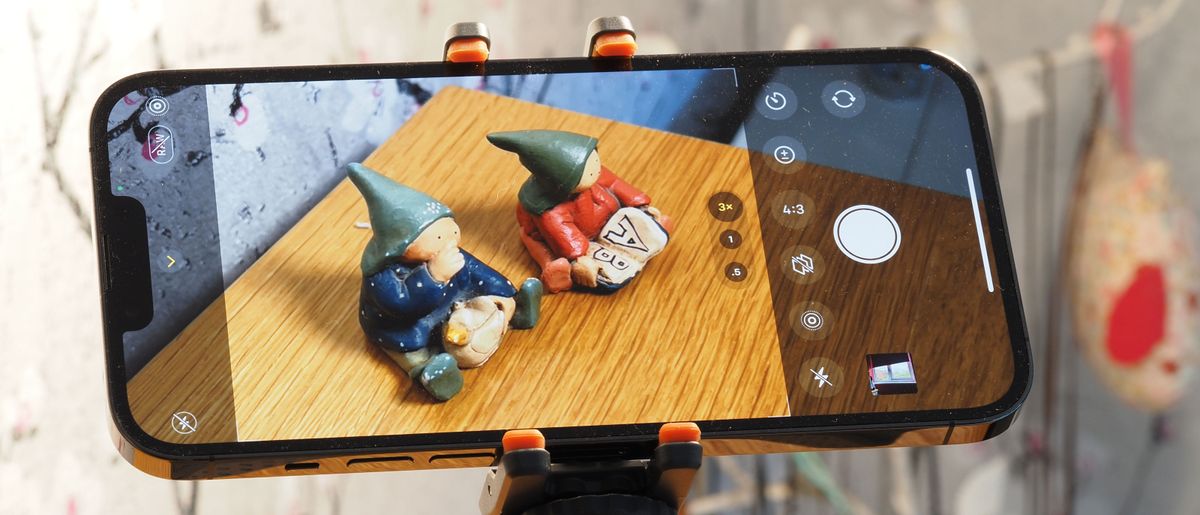Digital Camera World Verdict
The iPhone 13 Pro Max has a lot going for it as a phone, a phablet and an everyday companion that can manage almost every aspect of your life. But we’re taking a particularly close look at its camera features to see if the reality lives up to the hype. And you know what? It does. It might not replace your DSLR or mirrorless camera, but it really raises the bar for image quality, performance and features and leaves regular point and shoot cameras for dead. But you do have to think long and hard about choosing the Pro Max over the regular Pro. That bigger screen really bulks it up and does make it bit of a drag sometimes to carry around.
Pros
- +
Automatic macro mode
- +
Superb Cinematic mode
- +
77mm telephoto lens
- +
RAW capture
Cons
- -
More of a phablet than a phone
- -
Expensive, even by Apple standards
Why you can trust Digital Camera World
The iPhone 13 Pro Max is the biggest and best of Apple’s new-generation iPhones. There are four in total, including the pint-sized iPhone 13 Mini, the regular iPhone 13, the regular iPhone 13 Pro and this one. The 13 Pro has the same cameras and tech as the Pro Max, but the Pro Max has the biggest screen, at 6.7 inches versus 6.1 inches, and a slightly longer battery life of up to 28hrs video playback versus up to 22 hours on the smaller phone.
Apple would have to drop the ball in a really big way for the iPhone 13 Pro Max not to instantly become one of the best camera phones you can buy. And if that price tag does make you quake (we're all quaking a little), you can also check out our guides to the best budget camera phones or best burner phones instead.
Both iPhone 13 Pro cameras share the same spectacular three-camera array, and spectacular it is, both in its capabilities, its clever shooting modes and computational imaging tricks, and in the sheer quality of the results.
You only get the full suite of camera features with the Pro models, but they are the same for each, so the real decision is how much you want (or need) the bigger screen of the Pro Max.
Specifications
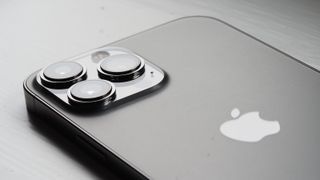
Rear cameras: 12MP 13mm f/1.8 Ultra Wide camera, 12MP 26mm f/1.5 Wide camera, 12MP 77mm f/2.8 telephoto camera
Zoom range: 6x optical
Front camera: 12MP f/2.2 TrueDepth
Display: 6.7-inch Super Retina XDR OLED (2778x1284 at 458ppi)
Chip: A15 Bionic, 6-core CPU, 5-core GPU, 16-core Neural Engine
Image stabilization: Dual OIS (Telephoto and Wide), sensor shift (Wide)
Max video resolution: 4K 60p
Waterproof: Yes (IP68 – down to 6 meters for up to 30 minutes)
Touch ID: No
Face ID: Yes
5G: Yes
Capacity: 128 / 256 / 512GB / 1TB
Dimensions: 160.8 x 78.1 x 7.65mm
Weight: 240g
Charger: Lightning (adapter not included)
See also: Best iPhone 13 Pro Max cases
iPhone 13 Pro Max camera features
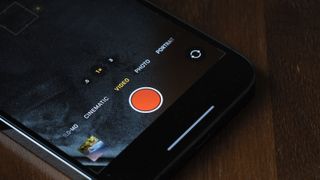
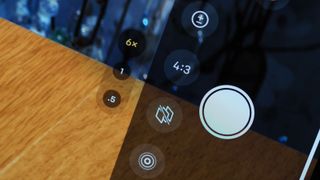
So let’s start with the iPhone 13 Pro camera system. Apple says this is its biggest upgrade yet, and while Apple says this every year, and while the changes might appear incremental rather than revolutionary at first glance, there’s a lot to talk about.
First, the new 13mm equivalent Ultra Wide camera has a wider f/1.8 aperture, all-new autofocus and a ‘faster’ sensor. Overall, Apple says, it can capture 92% more light. More than that, it has a new 2cm macro mode which engages automatically as you move up close to your subject and can capture tiny objects at a magnification that would previously have needed a clip-on macro lens. The macro mode works for video, too.
The regular Wide camera has a faster f/1.5 aperture and a larger sensor which incorporates sensor-shift image stabilization. Apple says this new camera captures 2.2x more light than its predecessor, and uses the iPhone’s LiDAR Scanner for Night mode portraits.
The telephoto camera has a longer 77mm equivalent focal length than before to offer a 3x telephoto effect relative to the regular Wide lens. Factor in the 0.5x Ultra Wide camera, and you have an overall focal length range of 6x – which seems to have been muddled up with a ‘6x zoom’ by some. To clarify, the 77mm telephoto camera offers 3x magnification, which is not the same as a 3x ‘zoom’ lens.
This camera array, in conjunction with the iPhone’s Camera app, iOS 15 and the might of the A15 processor, offers some terrific shooting modes.
• See also Best iPhone 13 Pro Max cases
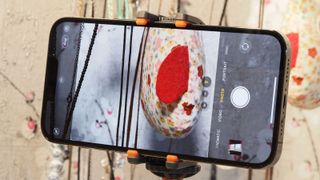
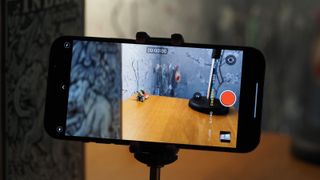
The macro mode, as already mentioned, kicks in automatically if you move the phone close enough to your subject – if you’re looking for it you can see the phone switch cameras at a certain distance (it’s the Ultra Wide camera that takes care of Macro shots). Interestingly, the phone maintains a very similar magnification and angle of view when it switches cameras, so we suspect it’s using some crafty computational trickery (digital zooming, in other words).
With Smart HDR 4, the iPhone 13 Pro can now pick out and optimise individuals in outdoor shots, and Portrait mode is as effective as ever at blurring backgrounds in people shots.
But now this background blurring/bokeh effect appears in the iPhone’s new Cinematic mode, which gives the appearance of shallow depth of field that you get with much larger sensors – the ‘cinematic’ look. The clever part is that this is done digitally, so the iPhone can automatically recognise people entering the frame, for example, and switch ‘focus’. Because it’s being done with processing not lens focusing, this means the iPhone can pull off the uncanny trick of offering focus adjustment AFTER you’ve captured your clip. Don’t like where it focused, or the speed of its pull-focus transition – then change it!
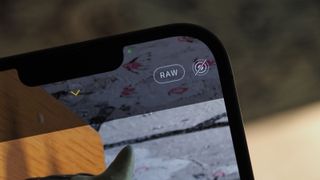
The iPhone 13’s video capabilities will take a further step forward when Apple adds ProRes video support in a future update ‘coming soon’.
The iPhone 13 Pro already offers the Apple ProRaw format for stills, which is essentially a generic linear DNG format that can in principle be opened by any raw software for shadow and highlight recovery, white balance adjustment and more control and quality overall.
iPhone 13 Pro Max: other features
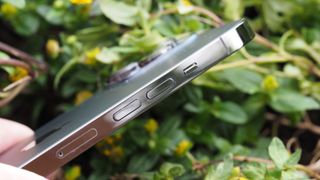
Camera array aside, the other dominant feature of the iPhone 13 Pro Max is its 6.7-inch display or, to give it its full name, its Super Retina XDR display with ProMotion. Apple says it’s up to 25% brighter outdoors and quotes a high-speed 120Hz refresh rate for ultra-smooth swiping movements and acceleration/deceleration to match your finger’s scrolling speed. The actual refresh rate will depend on what you’re doing and the apps you’re running, but it could make gameplay super-smooth.
Apple says the A15 Bionic processor incorporates an all-new 5-core GPU for up to 50% faster graphics performance than any other smartphone chip.
The body is made using ‘surgical grade’ stainless steel, its Ceramic Shield iii tougher than any smartphone glass, and the iPhone 13 Pro Max has IP68 water resistance, which means (says Wikipedia) that it is “dust resistant” and can be “immersed in 1.5 meters of freshwater for up to 30 minutes”.
You can get the iPhone 13 Pro Max with storage from 126GB right up to 1TB, and it comes in Sierra Blue, Silver, Gold, and Graphite.
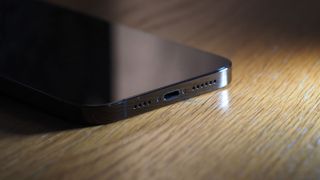
One word of warning: iPhones don't have memory card slots for extra storage and you can't upgrade the in-built memory later, so you have to make sure you get one with enough memory. Try to work out how much you think you will need... and then double it. It will make your phone even more expensive, but you almost certainly regret it later on if you scrimp on in-built storage.
Build and handling
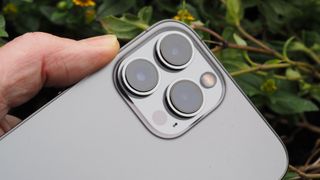
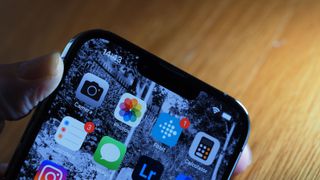
This a big phone. Not just big, but heavy-feeling. The 240g weight doesn’t sound a lot, but it’s packed into a pretty slim device, so it feels particularly dense and ‘weighty’.
When you’ve paid this much for a phone, you’ll probably want a decent case to protect it. We’d suggest something nice made of leather – our sample came with a utilitarian clear plastic Apple case which doesn’t look great and makes the 13 Pro Max pretty slippery to pick up from a flat surface.
Operation and handling are otherwise superb. You may not immediately notice the improved responsiveness of the screen, but iPhones have always been so good in this respect there’s not a lot of room for improvement.
You will need to use the in-built Camera app to get the full range of photo and video features. Other apps like Lightroom won’t have access to all of the things the hardware and OS can do.
For everyday practicality, we’d be tempted to stick to the regular iPhone 13 Pro. The photography and filmmaking features are the same, but while the 6.1-inch screen size doesn’t sound a lot on paper, there’s a very noticeable physical difference. The Pro Max is a great phone to keep on your desk or have by your armchair, but the regular Pro slips much more nicely into a trouser pocket.
But if you intend using the iPhone 13 as series content capture tool, the bigger screen of the Pro Max will be more important than its extra size and weight.
Performance


The iPhone 13 Pro Max’s performance is brilliant but not perfect. The fact is, it’s easy to forget that this is just a phone, and start applying regular camera standards to its stills and video performance – which is both pretty unreasonable, but also an indication of just how good phones have now become.
The still image resolution is ‘just’ 12 megapixels, and video capture tops out at 4K 60p, but the quality that Apple has produced within these limits is pretty extraordinary.
Below is a selection of 3-image galleries which show the angle of view of the iPhone 13 Pro's three camera:









Still images are crisp and clear with almost none of the small sensor ‘smoothing’ of fine detail that afflicts a lot of rivals, and the standard Wide camera lens is sharp from edge to edge. Apple’s HDR imaging is very, very good, and the provision of ProRaw format promises higher quality still.


If the iPhone 13 Pro Max has a weakness, it’s the Ultra Wide lens. On one hand, this is an exceptionally useful feature we should be pleased to have at all… but on the other, the edge sharpness isn’t as good as the regular Wide camera’s, and Apple’s digital jiggery pokery with the automatic macro mode switching doesn’t inspire a lot of confidence in macro shots unless you switch to the Ultra Wide lens first, so that you know there’s no digital zooming going on.
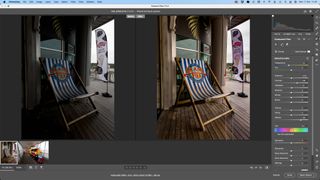
Regardless, the still image quality and the scope of this 3-camera array is pretty extraordinary – and if the still image quality is good, the video capture from this phone is better still. Apple already has an amazingly effective stabilisation system, so that the steady-handed video shooter might decide not to bother with a gimbal, but the new Cinematic mode is just amazing. Apple’s faux-bokeh effect might not stand ultra-close scrutiny compared to real bokeh, but the immediate visual effect is just stunning.
Verdict
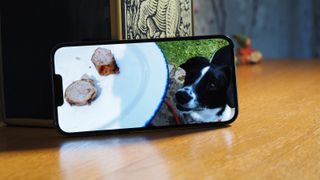
It might be tempting to pick the iPhone Pro Max over the regular Pro model just to get ‘the best of everything’. The regular Pro costs enough, so why not take that last step and get the bigger screen?
Well, it does change the handling dynamics somewhat. As a serious video camera (yes, we are serious) on a rig or a gimbal or a grip, the Pro Max’s size is not an issue and the bigger screen is an advantage. But if what you want is a stellar camera phone that’s also practical AS A PHONE, the regular iPhone 13 Pro might be your best choice.
And before anyone complains about the price, can we just mention the Sony Xperia Pro, which costs twice as much as the iPhone 13 Pro Max? It’s a different kind of device for a different kind of user, but who knew that one day Apple would offer a cheap alternative to Sony?
Read more:
• Best camera phones
• Best budget camera phones
• Best dumb phones
• Best burner phones

Rod is an independent photography journalist and editor, and a long-standing Digital Camera World contributor, having previously worked as DCW's Group Reviews editor. Before that he has been technique editor on N-Photo, Head of Testing for the photography division and Camera Channel editor on TechRadar, as well as contributing to many other publications. He has been writing about photography technique, photo editing and digital cameras since they first appeared, and before that began his career writing about film photography. He has used and reviewed practically every interchangeable lens camera launched in the past 20 years, from entry-level DSLRs to medium format cameras, together with lenses, tripods, gimbals, light meters, camera bags and more. Rod has his own camera gear blog at fotovolo.com but also writes about photo-editing applications and techniques at lifeafterphotoshop.com
